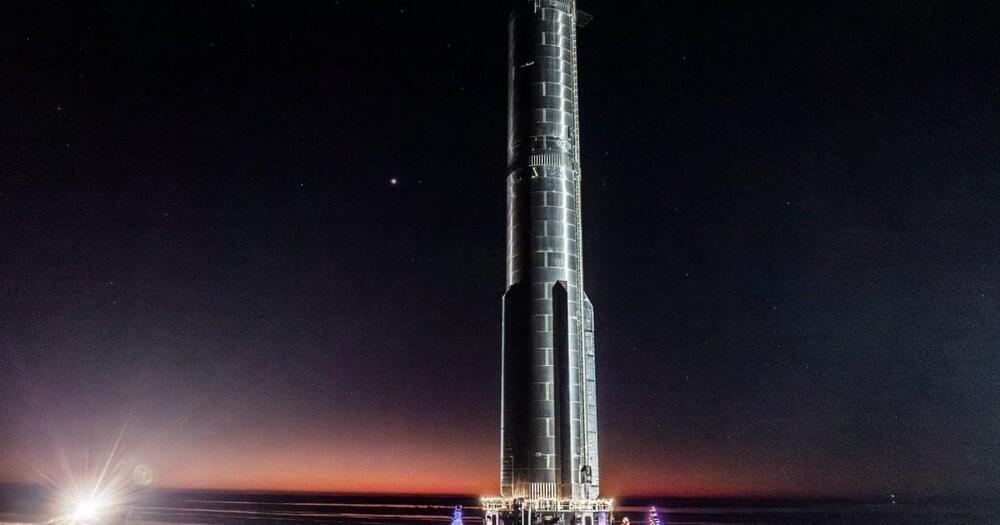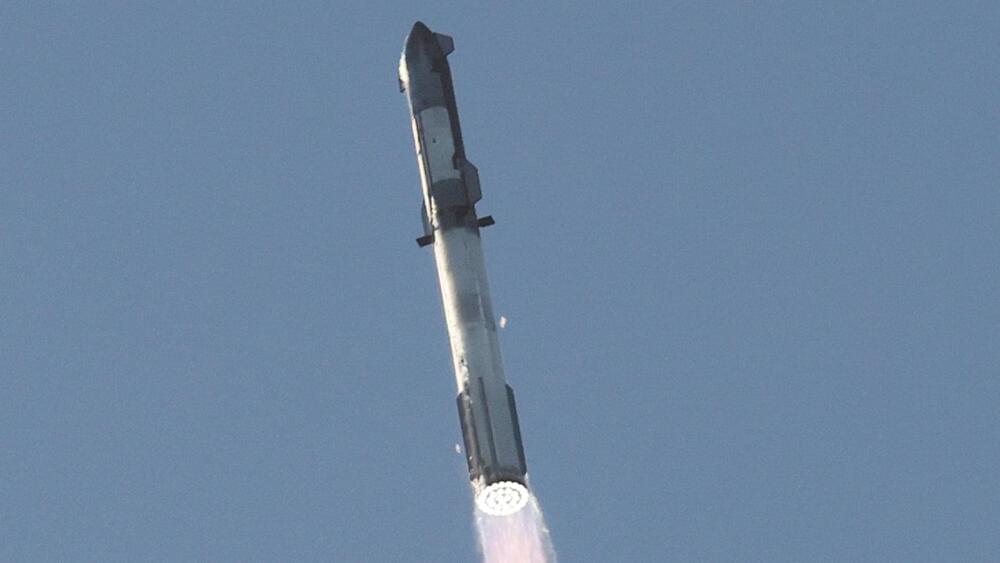What an exciting week it has been! We saw the rollout of both Ship 28 and Booster 10 down to the Gateway to Mars launch pad, and Ship 28 has alreadys starting undergoing tests, conducting a spin prime test over the weekend. Elsewhere, we had 3 mysterious launches from China, and strange lack of any Falcon missions, as well as a return to flight for Rocket Lab and Blue Origin. All of this and much, much more. Enjoy!
Category: space travel – Page 91

SpaceX shares stunning night shots of festive Super Heavy
SpaceX has shared a trio of awesome night shots showing its Super Heavy booster — the most powerful rocket ever built — being rolled to the launchpad ahead of its third test flight.
Look closely at the image above and you’ll see that the transporter carrying the 233-foot-tall (71 meters) booster is bedecked with Christmas decorations, including colorful lights, a tree, and a Santa Claus model. And for scale, take a look at the human captured in the extreme right of the frame.

NASA gives Blue Origin $35 million to turn moon dust into solar cells
NASA has awarded Blue Origin a $35 million contract to further develop a technology that creates solar cells out of lunar regolith — the dust and crushed rock blanketing the moon’s surface.
“[W]e’re inspired and humbled to receive this investment from NASA to advance our innovation,” said Pat Remias, VP of Blue Origin’s Capabilities Directorate. “First we return humans to the moon, then we start to ‘live off the land.’”
Moon or bust: NASA plans to send astronauts to the moon again as soon as 2025, with the goal of establishing a long-term presence on the lunar surface soon after. For that to work, it’s going to need a way to provide astronauts with a steady supply of everything they need to survive and thrive, from food and water to oxygen and electricity.

SpaceX’s V2 Starship: A Game-Changing Evolution in Space Technology
SpaceX’s announcement of the new V2 Starship marks a significant commitment to innovation and improvement in the evolution of Starship, with potential game-changing advancements in technology and capabilities.
Questions to inspire discussion.
Why is SpaceX shifting to V2 Starship?
—SpaceX is shifting to V2 Starship due to potential game-changing advancements in technology and capabilities, including increased propellant capacity and reduced dry mass for quicker booster return and reaching higher orbits.
SpaceX Confirms Possible Third Starship Launch Window
SpaceX is making significant progress in obtaining launch licenses, increasing their number of launches, and potentially extending the operational life of the Hubble Space Telescope through a rescue mission.
Questions to inspire discussion.
What progress is SpaceX making with the Starship launch?
—SpaceX is preparing for the third orbital Starship launch, with crews working to restore infrastructure and repair cracks at the launch site. They are also making design improvements and testing the deflector system.
Space Coast Live: 24/7 Views of NASA, SpaceX Falcon 9 Operations, and Starship Pad Construction
Space Coast Live provides 24/7 views of SpaceX and NASA launch operations in Florida including the new Starship pad at LC-39A. The Kennedy Space Center-based cameras are supplemented by Fleetcam, which provides views of recovery vessels in Port Canaveral.
Fleetcam is located at Rusty’s Seafood & Oyster Bar (https://www.rustysseafood.com/) in Port Canaveral, Florida. This stream has no audio commentary.
Our other livestreams!
Starbase Live: http://nsf.live/starbase.
McGregor Live: http://nsf.live/mcgregor

SpaceX valuation climbs to $180 billion
The valuation of Elon Musk’s SpaceX hit $180 billion based on an ongoing secondary share sale, CNBC confirmed Wednesday.
The company is discussing an agreement with investors to sell stock from insiders in a purchase offer at $97 a share, according to a person familiar with the discussions. The offer does not include raising new capital, as the purchase offer represents a secondary sale of existing shares and is expected to close in January.
SpaceX typically performs these secondary rounds about twice a year, to give employees and other company shareholders a chance to sell stock. The latest valuation represents a 20% increase from SpaceX’s previous high of $150 billion, which the company hit through a July secondary sale at $81 a share.

Newly created ultra-hard material rivals diamond
Potentially very useful discovery.
Scientists have solved a decades-long puzzle and unveiled a near unbreakable substance that could rival diamond as the hardest material on Earth. The research is published in the journal Advanced Materials.
Researchers found that when carbon and nitrogen precursors were subjected to extreme heat and pressure, the resulting materials—known as carbon nitrides—were tougher than cubic boron nitride, the second hardest material after diamond.
The breakthrough opens doors for multifunctional materials to be used for industrial purposes including protective coatings for cars and spaceships, high-endurance cutting tools, solar panels and photodetectors, experts say.